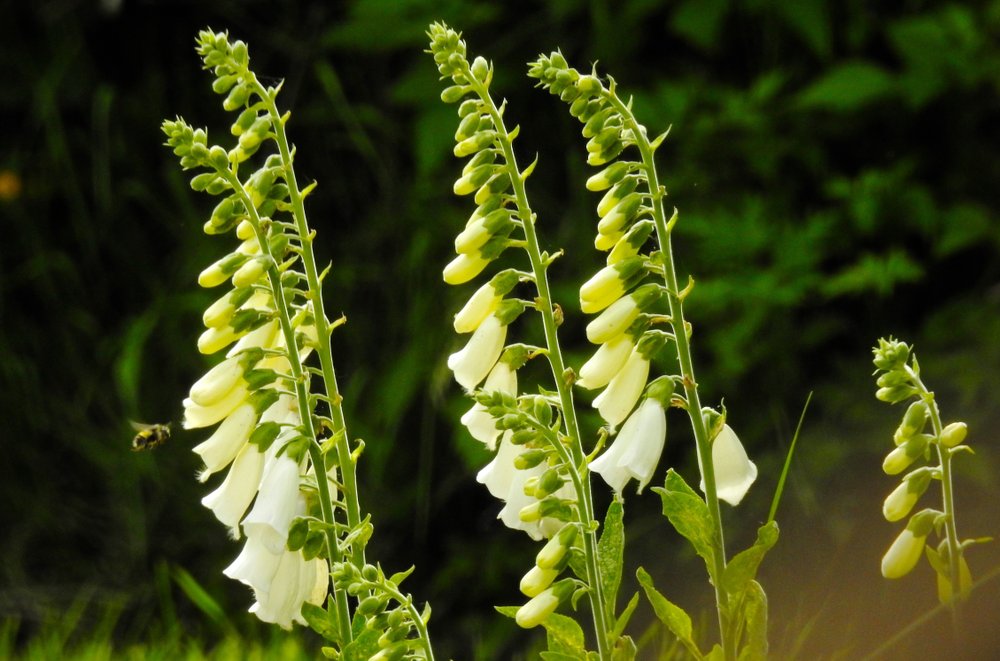
This June 2, 2019 photo shows a bumblebee approaching to feed from a group of foxglove (Digitalis) blooms in an orchard near Langley, Wash. (Photo: AP)
The lack of four-season food sources is one of the leading causes of the world’s declining bee populations. At certain times of year, there simply isn’t enough nutrition in the natural environment to fill the collective demand.
Rapidly increasing urbanization, fencepost-to-fencepost farming, and pesticide use are among the factors reducing the diversity and abundance of flowering plant species.
So what’s a pollinator-dependent gardener to do?
“Plant flowering plants,” said Rebecca Finneran, a horticulture educator with Michigan State University Extension. “People often only think of annual flowers as pollinator plants, but trees, shrubs, perennials, vines and herbs can provide a tasty diet for all types of pollinators.”
The overall pollinator collapse is worrisome because bees, wasps, flies and butterflies are instrumental in growing more than a third of the food that makes its way to our tables.
Some ways gardeners can help:
Determine when the hunger gaps occur in your area, which pollinator species are affected and then factor the appropriate plants into your landscape.
Emphasize biodiversity. Include wild bees along with honeybees in your planning, since different bees do different things. With over 4,000 species of wild bees in North America, the color, shape and size of blooms play a role in which type of pollinator will be attracted to your garden, Finneran said.
“The key is having a wide variety to ensure blooms will be available to pollinators throughout the season,” she said. “There is no ‘one size fits all,’ so I like to tell people to be thinking about mixing things up.”
Be a little passive when dealing with natural surroundings. Let weeds bloom, and minimize the use of chemicals that can weaken or kill bees. Deadhead pollinator-friendly plants like daisies, tall phlox and catnip for re-bloom. Wait to deadhead things like hosta until they have fully finished blooming, Finneran said.
Provide open ground and undisturbed areas for pollinator nesting cavities. Don’t plow them up, pave them over or rake them clean in the fall.
“People may run into city ordinances if they let their yards grow wild, so make them functional,” said Andony Melathopoulos, a bee specialist with Oregon State University Extension. “Make them into an attractive feature of your landscape while also making them into better pollinator habitat.”
Pollen is the only protein that bees eat. They can’t survive without it, nor can they raise their broods. Bees also collect nectar from flowers, using it to build their energy reserves while storing it briefly in their stomachs, where enzymes turn its sugars into a diluted honey.
Early spring can be one of the leanest times for pollinators, especially bees, Finneran said. “Cold, windy weather hinders long flights of some of our traditionally strong flyers,” she said.
You often see bees working in early blooming minor bulbs such as squill, or in an assortment of groundcovers, she said.
“Later in fall, we see a decline in resources, especially for bumblebees,” Finneran said. “Fall-blooming sedum, hyssop and snake root will offer these species food that will help them survive the winter.”
Eye-catching landscape design might be personally satisfying, but pollinators don’t care how your garden looks, Finneran said. Just offer them nutritious plants that bloom successively through the seasons.
“Design is a personal thing,” she said. “I have seen pollinators chasing a maintenance truck filled with spent sedum blooms.”


